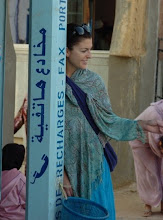
Mousharabia is the Arabic word for the screens that adorn middle and upper class houses and other historic buildings in the old medina. They refer mostly to the intricately carved screens that women sit behind in order to see what is going on below them without actually being seen. This architectural innovation comes from the Arab customs of gender segregation and the custom that women should not be seen unveiled by men outside their immediate family. Even then, they were required to express some modesty, covering their hair and most of their bodies. (This was especially common for upper class women.)
Although today women are more integrated into society, they are still expected to exercise modesty, piety, humility and correct sexual behavior- which requires them to stay out of spaces reserved for men in order to maintain their family's reputation. Many women opt for more conservative dress because they wish to ward off unwanted male attention, others choose to because they want to show their modesty, which holds significant value in Morocco when it comes to a woman's role in society.
Mousharabia are not widely used today to conceal women from the outside world, thus relegating to them to private spaces. Instead, they are artistic and architectural masterpieces of a time where women were forbidden from having active participation in public spaces. While they are beautiful in their individual designs, they serve as important reminders of the position of women in the classical Arab world. Here are some photos that depict some beautiful Mousharabia that I have had the opportunity to photograph during my stay here.










No comments:
Post a Comment